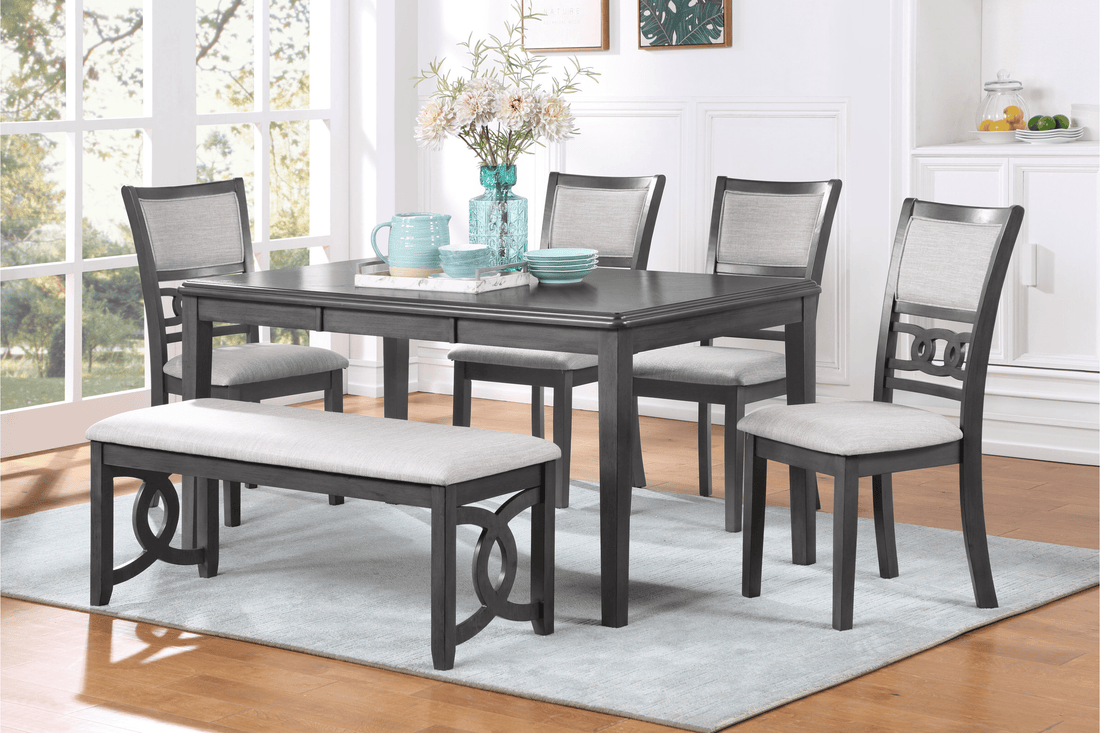When it comes to buying home furniture—whether it's a dining table, bed, or bookshelf—understanding what materials you're investing in is crucial.
You’ve probably come across terms like solid wood, engineered wood, or MDF, but what do they actually mean? And more importantly, how do they affect durability, aesthetics, cost, and longevity?
In this guide, we break down the differences between these three popular materials to help you make an informed decision on your next furniture purchase.
1. Solid Wood: The Classic Choice
What is Solid Wood?
Solid wood is exactly what it sounds like—furniture made entirely from natural timber, like oak, maple, teak, or pine. It's cut directly from the tree, with no fillers or bonding agents.

6PC Solid Wooden Dining Set with Bench
Pros of Solid Wood Furniture:
- Strength & Durability: Built to last for decades (or generations!) with proper care.
- Aesthetic Appeal: Rich grain patterns and a timeless, organic look.
- Repairable: Can be sanded, stained, or refinished multiple times.
- Eco-Friendly (when sourced responsibly): Biodegradable and natural.
Cons:
- Costly: Solid wood is more expensive due to raw material and craftsmanship.
- Heavier: Not ideal for renters or frequent movers.
- Moisture-Sensitive: Prone to warping, shrinking, or expanding with humidity changes.
Best For:
- Dining tables, beds, heirloom pieces, traditional or rustic interiors.
2. Engineered Wood: Strength Meets Efficiency
What is Engineered Wood?
Engineered wood is a broad category that includes products made by binding wood fibers, particles, or veneers with adhesives. It includes plywood, particle board, and MDF (Medium-Density Fibreboard), among others.
Unlike solid wood, engineered wood is man-made but designed to mimic wood’s appearance while offering enhanced stability and affordability.
Pros of Engineered Wood:
- Affordable: Typically less expensive than solid wood.
- Stable: Less prone to warping or splitting due to its layered construction.
- Versatile: Can be cut into various shapes and sizes.
- Eco-Friendly Options Available: Uses leftover wood material.
Cons:
- Lower Lifespan: May not last as long as high-quality solid wood.
- Limited Refinishing: Can’t be sanded or restained multiple times.
- Chemical Adhesives: Some types emit low levels of formaldehyde (check for E0/E1 certification)
Best For:
- Shelving units, entertainment centers, wardrobe panels, or modern built-ins.
3. MDF (Medium-Density Fibreboard): Smooth & Affordable
What is MDF?
MDF is a specific type of engineered wood made from tiny wood fibers compressed with wax and resin under high pressure. It's denser and more uniform than particle board and is often used in budget-friendly or mass-market furniture.
Pros of MDF:
- Super Smooth Surface: Ideal for painting and laminating.
- Budget-Friendly: A cost-effective alternative to solid or plywood furniture.
- Consistent Density: No wood grain means fewer weak spots or inconsistencies.
- Easily Moldable: Often used for intricately carved furniture pieces or cabinet doors.
Cons:
- Weaker than Plywood: Less resistant to heavy loads or prolonged moisture.
- Not Water-Resistant: Swells quickly when exposed to water.
- Shorter Lifespan: Ideal for temporary or light-use furniture.
Best For:
- Kids' furniture, painted cabinets, indoor decorative panels, bookshelves.
How to Choose: Key Considerations
When selecting the right material for your home furniture, it's essential to consider more than just looks. Durability, usage, and even climate can play a big role in making the best choice. Here's a breakdown of key factors to guide your decision:
1. Budget
If you're working within a tight budget, MDF or engineered wood may offer the best value for money without compromising on style. However, if you're aiming for a long-term investment that will withstand the test of time, solid wood is a premium choice known for its durability and timeless appeal.
2. Function & Load
Furniture that bears a lot of weight or frequent use—like beds, dining tables, or sofas—is better suited to solid wood or high-grade engineered wood. For lighter-use or decorative items, MDF and lighter boards are perfectly adequate and more economical.
3. Moisture Exposure
In damp or humid environments like bathrooms, basements, or kitchens, avoid using MDF as it can swell or deteriorate. Instead, opt for moisture-resistant plywood or specially treated engineered wood for improved longevity.
4. Aesthetic Preference
Love the charm and uniqueness of visible wood grain? Solid wood brings natural beauty that can be stained or refinished over time. If you prefer a sleek, uniform finish, MDF works beautifully with laminates, paint, or veneers for a modern, polished look.
These considerations will help ensure that your furniture not only looks great but also performs well in your specific home environment.
At Nova Furniture Mall, we believe in transparency and quality. Whether you're choosing a furniture piece made from engineered wood or solid wood. We ensure every piece is built for comfort, style, and value.
Visit our showroom or explore our online store for personalized recommendations and expert support.




